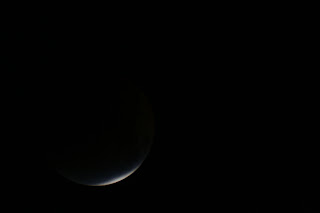
This is the setup used for the eclipse pictures shown below. There was a constant, varying haze in the sky, necessitating some exprimenting with exposure times. The final phases were not captured, because solid clouds obscured the Moon in the end.

As mentioned before, this morning a total eclipse of the Moon occurred. I woke up just in time to witness and photograph the event. The above image shows the Moon just disappearing into the Earth's shadow.
This shows the Moon when it had moved well into the Earth's shadow:

The orange tint is the result of the sunlight refracted around the Earth. As seen from the Moon, the Earth would seem to be surrounded by a "ring of fire" of this orange colour. It's like a sunset, except as seen from far away in space, with the whole Earth blocking the Sun.
The Moon is now at midpoint of the total eclipse:

Taken with a Canon Rebel XT through a Celestron C90 telescope at f11 (= a 1000mm focal length telephoto lens - see top image) and an exposure time of 3.2 seconds, sensitivity at 800 ASA.
Added on Aug 31:
You'll notice that the Moon does not appear quite sharp in one direction here. The cause is the Earth's rotation.
There is a faint image of a star streak close to the left edge of the image. The length of this streak tells you how much the image shifted due to this motion during the 3.2 seconds. If I had used my "equatorial" mount, and attached the telescope and camera to it, there would have been no "smear"; that type of mount compensates for the rotation, and is used for those astronomical photos which require many minutes or hours of exposure time.
Leaving the Earth's shadow:
f11 at 1/20 sec

f11 at 1/160 sec

Wow! Amazing pictures. It certainly didn't look that majestic from my porch.
ReplyDeleteExcellent pics. Thank you for posting these for those of us that just can't stay up that late anymore.
ReplyDeleteI love "Leaving the Earth's shadow." So three dimensional.
ReplyDeleteKarl.....The pictures are just great! I was up for work at 4am but completely forgot the eclipse. By the time I was on the road at 5:30 am it was all over. I'm so glad you posted the pictures....they are amazing. Barbra
ReplyDeleteLucky you ... no fog!
ReplyDeleteBeautiful exposures.
I was fortunate enough to watch the eclipse as well and you captured some great pictures. The most impressive views, besides the color, was when the moom started coming out of the earths shadow. It was incredible, and your picture captured one of those moments.
ReplyDeleteThis comment has been removed by the author.
ReplyDeleteWow these are amazing photographs!
ReplyDeletedo you have any other magnificent pictures to share?
I'm unfamiliar with the Celestron C90 telescope. Does it allow you to program it by hooking it into a computer to point it at particular celestial objects?
The Celestron telescope is of a type called "Maksutov". There is no requirement for any special type of telescope, any long-focus lens will do for photography of the Moon. The reason you need a "long" lens is that the Moon covers only 1/2 degree in the sky - there are 180 degrees from East to West or North to South horizon. That means that the Moon covers only 1/360th of that; it's small in comparison to the whole sky.
ReplyDeleteThe longer your telephoto lens, the smaller the area of the sky it can cover. So, if your coverage of the sky is 4 degrees in diameter, you can fit the Moon in there 8 times. If your coverage is 2 degrees, the Moon fits into that 4 times. In my blog pictures, the Moon fits into each frame about 3 times (lengthwise), this means that the total image covers about 1.5 degrees.
There is no computer control necessary to photograph the Moon - exposure times are equivalent to those of regular daytime exposures made with the same sensitvity setting in your camera.
The story changes if you make photos of stars and nebulae. For that, longtime exposures (many minutes) are necessary. This requires a telescope "mount" (often a specialized tripod), which allows following the motion of the sky, caused by the daily rotation of the Earth (this is the cause of sunrise and sunset). This keeps the stars in the same spot form the observer's and camera's point of view.
The most basic mounting of this type must be aligned parallel to the "Earth's axis". This is an imaginary axis around which the Earth rotates. It ends at the North and South poles. The second requirement is that the mount will move the attached telescope or camera at the rate at which the Earth rotates, but in the the opposite direction of that rotation (once every 24 hours for one complete rotation). The Earth turns from West to East, therefore the telescope mount must turn from East to West at the same speed. This speed is 1/2 that of the hour hand on our clocks.
This is a fixed speed, so computer control is unnecessary. In earlier centuries, a mechanism similar to a wind-up clock did this job. Nowadays, this is most often done by and electric motor, either battery or standard power driven.
Computerized telescope mounts come into play only if you want to automate the search for stars or other object in the sky, or when you don't know how to find these yourself by hand. I recommend this kind of use only once you've become familiar with the sky. If the power fails, you can still find and look at things - without that knowledge, you're kind of "lost".